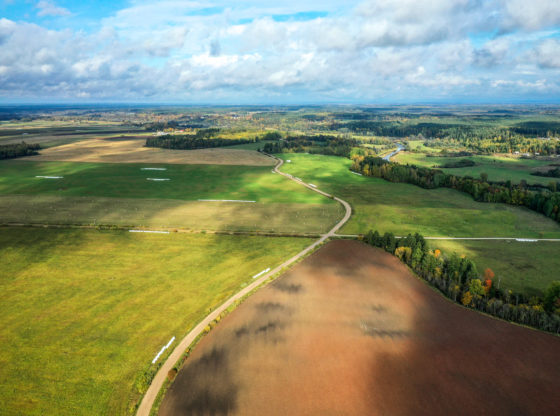It has already been more than a year of active implementation of the LIFE OrgBalt project and the key milestones of 2021 were reached. All 17 demonstration sites were established in Latvia and Finland, with additional reference sites across the Baltic States, altogether 53 study sites. Regular greenhouse gas (GHG) flux measurement and environmental data collection are continuously taking place at all study sites. This task is complex and long-term and is executed with a state-of-art methodology. At this point, with the dataset of the first full year measurements, the work on data analysis can begin.
The project focuses on exploring and demonstrating the potential for GHG reduction and increase of carbon sequestration in fertile organic soil management. An important part of the project outcomes will be developing and implementing climate change mitigation measures that promote a scientifically sound approach to land use and climate policy planning documents.
One of the main objectives of the LIFE OrgBalt project is to provide tools and guidance for the elaboration, implementation, and verification of efficiency of climate change mitigation (CCM) policies that includes the elaboration of the digital tools set. 2021 was a productive year for developing the concept and structure as well as programming of the logic of several digital tools to be elaborated during the project. The project team worked on equipping the tools with data required, testing the product and training the potential users of those tools. Some of the digital tools are already available for the general public to use.
In summer 2021, the complete depth-to-water maps for the entire territory of the Baltic States were created. This single source of information allows modelling the water accumulation sites by showing water table depth in meters. At the end of 2021, another digital tool – wet area maps for the territory of the Baltic States was created, which soon will be available for the general public. The wet area maps are generated in 5 m horizontal resolution and show the surface of water objects, areas and possible accumulation areas of surface water. The set of water maps is a practical tool for planning sustainable soil management activities both in the forestry and agricultural sectors.
The public and private sector cooperation model (PPC model) is one of digital tools developed in 2021. The PPC model was created to examine the benefits and costs of proposed CCM practices, financing opportunities, institutional arrangements and enabling conditions that could motivate the implementation of CCM measures. This is a support tool for estimations of the economic benefits of the CCM land-management measures on multiple levels – national and individual farm level. At the current development stage, three CMC scenarios are incorporated, and the work on developing a complete set of scenarios with several data levels for more accurate estimations continues.
Elaboration of the simulation model (SM) for regional level projections of GHG emissions and socio-economic outputs was started in 2021. The SM is a policy planning support tool for the application at a local or regional level for projections of GHG emissions and socio-economic consequences of selected management options and initial conditions. The SM is designed by combining CCM measure data, GHG emission factors and socio-economic estimates. Activities continue on developing and updating the necessary geospatial information layers with data on soil, water and land use related indicators in all target countries.
Another digital tool elaborated within other project but successfully tested for the project needs and adopted to the circumstances of the Baltic States is the peatland simulator SUSI created by the Natural Resource Institute Finland (Luke). The simulator uses a hydrological model that requires weather and stands data inputs to estimate water table levels and create projections of GHG emission levels in organic soils. The model’s value is in producing these estimates for sites for which actual greenhouse gas measurements are not available. This kind of modelling requires weather and stands data only, which are readily available.
Examination of the latest EU policy strategies documents were done to summarise main policy settings and targets related to organic soils to ensure that the expected results of this project are in line with future policy initiatives.
In 2021, the project was widely represented in various events. One of the proudest moments for the project team was the side event organised at the UN Climate Change Conference COP26 Peatland Pavilion. Moreover, LIFE OrgBalt representatives took part in the technology and innovation festival in Latvia, CAR-ES forest network seminar in Iceland, International Peatland Congress in Tallinn, European Soil Partnership Partner Assembly, and more events across Europe.
The LIFE OrgBalt partners strive to communicate the importance of the project actions to both the general public and industry experts. For example, in 2021, the project team developed articles that explain the topics of climate change mitigation and adaptation measures, the connections between land use and climate change, and more. The industry experts and practitioners were addressed with technical articles on the Peatland simulator SUSI and Depth-to-water maps. Moreover, a short documentary on the project objectives and partners was created.
More information:
The project “Demonstration of climate change mitigation potential of nutrient rich organic soils in Baltic States and Finland” (LIFE OrgBalt, LIFE18 CCM/LV/001158) is implemented with the financial support of the LIFE Programme of the European Union and the State Regional Development Agency of Latvia.
The developed material reflect only the LIFE OrgBalt project beneficiaries’ view and the European Climate, Infrastructure and Environment Executive Agency is not responsible for any use that may be made of the information contained therein.


